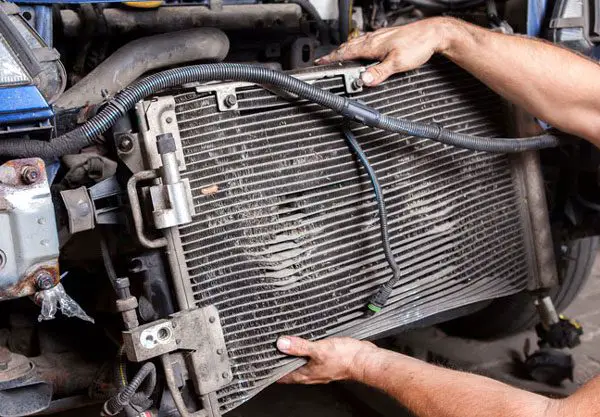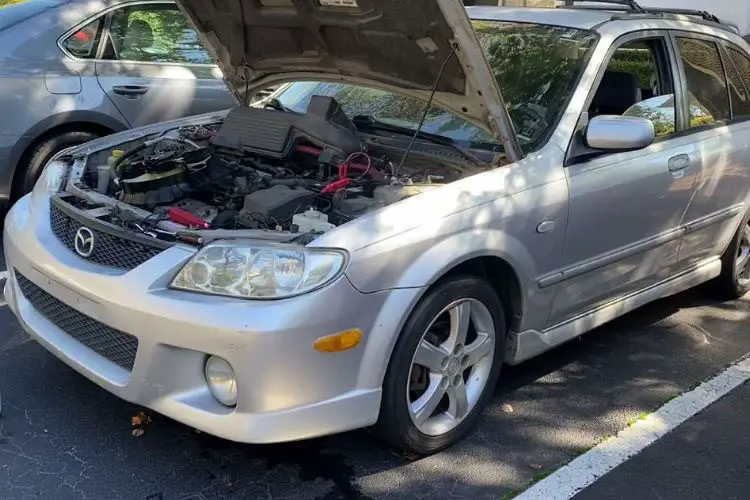When a car overheats, the most common fix is replacing the thermostat and water pump. However, the car will sometimes overheat after this fix, indicating more problems.
Why is your car still overheating after replacing the thermostat and water pump? That could result from a faulty head gasket, a malfunctioning radiator, or a cracked head cylinder. Sometimes, the cooling fan is stuck or broken, the drive belt is worn out, or the temperature sensor is damaged.
Read on to learn how to diagnose overheating issues, how to fix them, and how much the repairs cost.
Car Still Overheating After Replacing Thermostat And Water Pump

Several issues can cause your car to overheat even after you swap out the water pump and thermostat. They are discussed below.
1. Faulty head gasket
The head gasket seals the engine, maintaining the compression required to burn the fuel mixture. This seal also helps keep the coolant and oil in the engine and prevents leaks.
A blown head gasket will cause the engine to leak oil. Since oil helps lubricate the engine and reduce friction, low oil levels can lead to overheating. A faulty head gasket will also allow coolant to leak, causing the engine to overheat.

You cannot fix a blown head gasket, so the only repair is a replacement. However, since replacing a head gasket involves taking apart the engine, it is a complicated and time-consuming repair that’s best left to a mechanic.
2. Warped cylinder head
Similar to the head gasket, the cylinder head sits on the engine and maintains compression. It also has valves that allow air into the engine. A warped cylinder head causes overheating because it restricts the motion of pistons and interferes with airflow into the engine.
There are two main ways a cylinder head gets damaged; warping or cracking. A qualified mechanic can flatten a warped cylinder head back into shape. On the other hand, a cracked cylinder is beyond saving and must be replaced with a new one.

3. Faulty radiator hoses
Hoses help transfer coolant between the radiator and the engine. They can clog due to debris build-up and burst when hot coolant expands within them. Clogged, constricted, or burst hoses interfere with coolant flow, causing the engine to overheat.
Though you can patch up radiator hoses, the best thing to do is replace them with new ones. If the hoses are clogged due to debris, flush them to clear out the debris.

4. Cracked drive belt
A drive belt’s job is to power the compressor, alternator, water pump, and fan clutch by transferring power from the engine. If the drive belt is cracked or damaged, it won’t power the water pump, so coolant won’t circulate in the engine. As a result, the engine will overheat.
The best fix for a damaged drive belt one is swapping it out for a new one.

5. Faulty radiator
The radiator’s main function is to remove heat from the engine and keep it cool. It works with the water pump to get hot coolant, cool it, and then send the cooler liquid back to the engine.
If your car overheats even after replacing the water pump, the radiator is most likely malfunctioning.

Find a good radiator sealant and follow the process below to fix any leaks;
- Open the radiator cap and pour in the sealant. Do not drain any coolant in this step
- Fill up the radiator with coolant to the recommended level
- Run your engine for 10 minutes to circulate the coolant and sealant. This way, the leaks will be closed by the sealant
- Top up the radiator coolant and let the car sit for a day
6. Faulty cooling fan
Your car’s cooling fan only kicks in when the engine is running while the car is stationary. It may also turn on when the engine temperature is too high and is typically activated by the thermostat.
If your car overheats after replacing the thermostat, your fan may be stuck. A stuck cooling fan isn’t able to rotate, so it can’t push air into the engine and cool it. The fan’s circuit may also be faulty, making the fan unresponsive.

In case your cooling fan is stuck or touching some other engine components, move it so it can rotate freely. Replace melted wires or blown fuses to fix the fan circuit. Finally, if the fan is beyond repair, replace it with a new one.
7. Faulty sensor
Sensors like the coolant temperature sensor monitors the engine to ensure it operates optimally. If the temperature sensor is inaccurate, the cooling fan may fail to turn on, leading to overheating.
The best fix for a bad temperature sensor is to replace it with a new one.

Signs That Indicate Overheating Problems?
If you’ve replaced the thermostat and water pump, and your car is still overheating, use the table below to diagnose the problem.

| Components to check | Signs to look for |
| Radiator | Coolant leaks under the car |
| Discolored coolant fluid | |
| Head gasket | The engine will lose power |
| White smoke out of the exhaust | |
| Engine oil contaminated with coolant and coolant contaminated with engine oil | |
| Low coolant level without obvious leaks | |
| Drive belt | AC and power steering malfunction |
| Weird squealing noises from under the hood | |
| Cylinder head | Engine misfires |
| Smoke coming out of the hood | |
| Low coolant levels without visible leaks | |
| Radiator hoses | Low coolant levels |
| Crust formations where the hose connects to the radiator | |
| Coolant leaks along the hoses | |
| Constrictions or burst sections | |
| Soft, swollen patches due to the pressure of coolant expansion | |
| Cooling fan | Blown fuse or melted fan circuit wires |
| AC performs poorly or refuses to turn on | |
| Loud whirring noises when the fan is stuck | |
| Engine coolant temperature sensor | Check engine will turn on |
| Black smoke out of the exhaust | |
| Poor gas economy |
How Much Does It Cost To Fix Overheating Problems?

The prices of the replacement parts, like the fan and head gasket, range between $20 and $350, while labor costs are around $75 to $130 per hour. Since replacing parts like the head gasket is time-consuming, total repair costs can be more than $1,000.
However, if you have to replace the engine, the cost lies between $2,500 and $10,000, or more, depending on engine size and car model.
How Can I Stop My Car From Overheating?

Fixing an overheating car can be highly expensive, so it’s wise to prevent the problem. Here are a few tips on how to stop your car from overheating;
- Check your radiator and radiator cap regularly and ensure it is in good condition
- Monitor and regularly top up the coolant in the radiator so that it never falls below the recommended level
- Regularly check the engine oil level and its condition. If the oil looks contaminated, change it immediately
- Avoid overusing the car’s AC because that can increase the likelihood of overheating

FAQs
Here are some answers to questions about overheating problems.
No. You should never drive your car with an overheating engine because that can cause permanent damage to the engine.
An engine can only survive overheating for a maximum of 1 minute. So, if you think your car is overheating, stop it immediately.
Conclusion
If your car still overheats after replacing the thermostat and water pump, some underlying problems are causing the issue. The fault may lie with components like the cooling fan, radiator, head gasket, sensors, head cylinder, or even the drive belt.
And fixing overheating issues typically involves swapping out parts for new ones. These replacements can cost anywhere between $200 and $10,000, or more depending on what part you’re replacing. Fortunately, overheating can be avoided by checking coolant and oil levels regularly.
